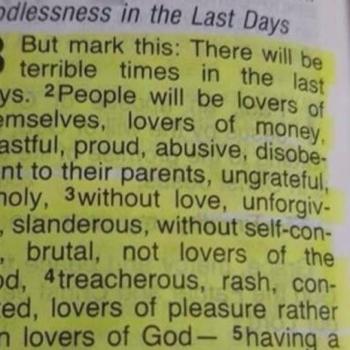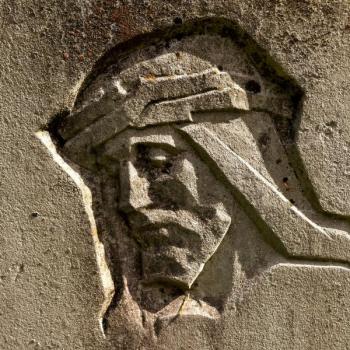We find the Apocalypse of Weeks in 1 Enoch 91 and 93. As an apocalypse it is a heavenly revelation previously hidden from human knowledge. This revelation depicts a total of ten different weeks. The weeks stand for various eras of human history, and the final weeks point to the very end of that history. As we begin a new year of uncertainties, what can we learn from this neglected prophecy?
This prophetic discourse appears in the fifth and final major portion of 1 Enoch known as the Epistle of Enoch (or Testament of Enoch). Chapters 91–105 express Enoch’s final words and farewell address to his family before he is permanently taken up to heaven. According to what we find in Genesis 5:24, he never died—Enoch walked with God and God took him!
Given that fragments of this section in 1 Enoch appear in the Dead Sea Scrolls (4QEng), the prophecy may be very old, perhaps written before the time of the Common Era before Christ.
The Apocalypse of Weeks: 1 Enoch 93:1–10 + 91:11–19
During the many years of the textual transmission of 1 Enoch, it appears that this prophecy was split apart by accident prior to an editor giving the document chapters and verses.

Daniel C. Olson explains: “sometime during the long transmissional history of the text it seems likely that a page with Enoch 92:3–93:10 on the front and 91:11–92:2 on the back was flipped over, radically disordering this section… With the help of DSS [Dead Sea Scrolls] fragments [of 1 Enoch], the original sequence can be recovered with a fair degree of confidence.”* Another option is that a redactor from antiquity deliberately inserted 91:11–17 in its present location.**
Since chapter 91 names weeks eight through ten, and chapter 93 names weeks one through seven, the original order seems to have first included 1 Enoch 93:1–10 first and then 91:11–19.
Ten Weeks
Enoch begins by addressing his children—Methuselah and other siblings—about what was revealed to him from a heavenly vision, holy angels, and what he learned from the heavenly tablets. These tablets, also in 1 Enoch 81:1–12, record all the deeds of humankind.
Week 1
During the first week Enoch was born on the seventh “day” of the week. Righteousness characterized this period of time (1 Enoch 93:3), though certain manuscripts also include judgement, presumably on the Watchers, fallen angels who mated with earth women (cf. 1 Enoch 6–11).
Week 2
The second week, after the time of Enoch, there will be a time of wickedness. The first consummation will take place, which refers to the Great Flood in Noah’s day. The man (Noah) will be saved (1 Enoch 93:4; cf. Gen 6–7). But after this, the earth again will be filled with even greater injustice, and one will establish a law for sinners.
This time after the Flood seems to reflect the Tower of Babel incident (cf. Gen 11). If this law-establisher for sinner refers to Noah, this may imply the Noahide commandments, inclusive of prohibitions against idolatry, murder, adultery, theft, and other charges (Gen 8–9; Jubilees 6.27–29). The other possibility is that this law refers to the Code of Hammurabi established by the Babylonians (c. 18th century, BCE), which would be prior to the time of Moses.
Noahide commandments, however, seem the more likely interpretation given Noah’s importance in this book. These commandments operate as laws for the gentile nations, understood as “sinners” here. In the New Testament, Paul seems to hold Noahide commands as a standard by which gentile nations of the past are expected t know God’s “righteous requirement” (Rom 1:32). Gentiles would not know Moses’s commands.
Week 3
In the third week, a man will be chosen as “the plant of the righteous judgment” (93:5). This appears to be Abraham. After him there will spring forth an “eternal plant of righteousness,” which may refer to Abraham’s descendants, especially Jacob-Israel. We notice similar plant imagery for Israel in Isaiah 5. In the New Testament, Paul’s olive tree illustration seems to have Abraham as its root (Rom 11:17–24).
Week 4
In the fourth week, visions of the “holy” and “righteous” will be seen, and a law will become an enclosure for all generations. This appears to refer to Mt. Sinai during the time of Moses and establishment of Mosaic law, the Torah (93:6).
Week 5
The fifth week depicts a house of “glory” and “dominion” that will be built forever. This seems to refer to Solomon’s temple (93:7).
Week 6
In the sixth week, those in it will be blinded and their hearts will stray from wisdom. A certain man shall ascend, the house of the kingdom will be burnt, and the chosen root will be dispersed. This may refer to Israel’s cycles of apostasy during the divided kingdom and its latter kings that we read about in 1–2 Kings and in the Chronicles. Israel’s Assyrian and Babylonian exiles are the outcome of Israel’s apostasy. The ascended man, similar to Enoch, is Elijah the prophet who also escaped death by being taken up in a whirlwind at the appearance of a chariots of fire. (93:8).
Week 7
The seventh week will see an apostate generation. At its completion the elect will be righteous witnesses from the eternal plant, and they will be given sevenfold wisdom and knowledge. They will uproot violence, deceit, and execute judgment (93:9–10; 91:11).
Scholars suggest here that the author of 1 Enoch (who obviously is not really Enoch) may be writing about his own period. The sevenfold wisdom may be the Book of Enoch. The uprooting of violence may reflect the Maccabean revolt against the Hellenistic monarch, Antiochus IV (1–4 Maccabees). One view suggests that each of the first seven weeks represent 490 years, which leads up to the Maccabean era in 164 BCE.*** Otherwise, the seventh week may anticipate some end-time vengeance against foreign enemies and the reestablishment of dominion.
Week 8
The eighth week now comes and is considered the “week of righteousness.” The sword of the righteous prevails and executes judgment on the sinner. Also, a house (temple) will be built for the Great King forever (91:12–13). This appears to be something in the future for the author of 1 Enoch. It looks to the Messianic hope of overcoming enemies and reestablishing an everlasting kingdom and future temple.
Nickelsburg writes here that “Hopes for the building of the eschatological temple and the New Jerusalem (the two cannot be easily separated) are expressed already in Third Isaiah (56:7–8; 60; 65:17–25) and in literature that is based on this prophet’s word (cf., e.g., Tob 13:9–18; Revelation 21–22; cf. also Sib. Or. 3:702–31; 2 Bar. 4:2–7; 4 Ezra 10” (1 Enoch 1:449). Similarly, in Paul see 2 Thessalonians 2:1–12.
Week 9
The ninth week then comes in which the righteous judgment is revealed to the world. Also, all “the workers of iniquity will wholly vanish from the entire earth; they will be cast into the Eternal Pit, and all men will look to the path of everlasting righteousness” (91:14; Olson, “1 Enoch,” 937). This week seems similar to the nations returning to Zion to worship the one true God, as predicted in e.g., Isaiah 2; 59–62. This is then the reversal of the Tower of Babel, and it perhaps reflects final judgment for humankind.
Week 10
Then a tenth week shall come and eternal judgment by angels takes place. The first heaven departs and a new heaven appears with the powers of heaven shining sevenfold forever. After this, many more weeks will come, all with goodness and righteousness. Sin will be eradicated (91:15-17).
Here judgement on the Watchers, who ruined everything at the beginning of 1 Enoch, takes place. The ninth and tenth weeks are generally consistent with Revelation 19–22 and Paul’s description of the Parousia of Jesus Christ in which all enemies and principalities will be defeated (1 Cor 15:20–28).
In 91:18–19 Enoch gives an exhortation showing the righteous way; his children are to walk in it and not walk in the way of wickedness. Those who walk in injustice will perish.
Closing comments on the 10 Weeks
One finds in the Apocalypse of Weeks a chiastic (inverted) structure: ****
A. Week 1: the first judgment on the Watchers

B. Week 2: the first judgement on humans
C. Week 3: establishment of righteous and their role in judgment
D. Week 4: Mosaic revelation
E. Week 5: first temple built
E.’ Week 6: first temple destroyed
D.’ Week 7: Enochic revelation
C.’ Week 8: establishment of righteous and their role in judgment
B.’ Week 9: The last judgement on humans
A.’ Week 10: The last judgment on the Watchers
This apocalypse as a panoramic history bears similarities with the Book of Daniel 8, 10–12; Second Baruch 56–71; the Animal Apocalypse of Enoch in 1 Enoch 85–90; and the Sibylline Oracles 1, 2, 4 (cf. Nickelsburg, 1 Enoch 1:439–440).
The Apocalypse of Weeks also bears some similarities with other apocalyptic texts such as the Book of Revelation. Some regard such prophecies to have a futuristic remainder that still needs to be fulfilled. Similar to Revelation also, the Apocalypse of Weeks repeats a strong moral message distinguishing the righteous from wicked sinners. The elect people are thus encouraged to remain faithful and true to the Lord.
Weeks 8, 9, and 10 appear to be futuristic from the perspective of the author of 1 Enoch. Week 8 would be next on the forecast depicting the triumph of the righteous. We may either choose to consider these predictions to be in error or accept them as authentic prophecy. Then again, we can simply reflect on how they compare and contrast with canonical texts and other non-canonical texts.
What can we learn about 2024 through this apocalyptic text? Virtually nothing if we are trying to pinpoint prophetic “calendar” events. Its message nevertheless encourages true believers to be among the righteous regardless of any wild ride up ahead.
Notes
* Daniel C. Olson, “1 Enoch,” in Eerdmans Commentary on the Bible, ed. James D. G. Dunn and John W. Rogerson (Grand Rapids: Eerdmans, 2003), 936. See further, Olson, “Recovering the Original Sequence of 1 Enoch 91–93,” Journal for the Study of the Pseudepigrapha 11 (1993) 69–94.
** See discussion in George W. E. Nickelsburg, 1 Enoch, Hermeneia (Minneapolis: Fortress, 2001), 414–15.
*** Klaus Koch, “Sabbatstruktur der Geschichte: Die sogenannte Zehn-Wochen-Apocalypse (1 Hen 93:1–10; 91:11–17) und das Ringen um die alttestamentlichen Chronologien im späten Israelitentum,” Zeitschrift für die Neutestamentliche Wissenschaft 95 (1983) 403–30.
**** See J. C. VanderKam, “Studies in the Apocalypse of Weeks (1 Enoch 93:1–10; 91:11–17),” Catholic Biblical Quarterly 46 (1984) 512–23.


















